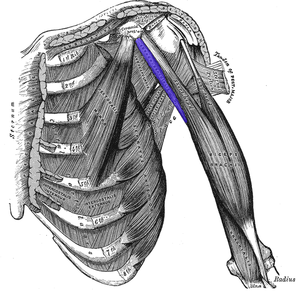Description
Coracobrachialis muscle is one of the three muscles that originates from to the coracoid process of the scapula. It is situated at the superomedial part of the humerus[1].
Origin
Apex of the coracoid process, in between the pectoralis minor and short head of biceps brachii muscle
Insertion
Its tendon attaches to the linear impression at the medial side of the midshaft of the humerus
At the glenohumeral joint, the coracobrachialis
- flexes and adducts the humerus.
- assists in arm internal rotation
Blood Supply
It’s blood supply is by a branch of the brachial artery.
Innervation
It is innervated by musculocutaneous nerve which pierces it.
Clinical Relevance
The nutrient foramina of the humerus is located at the region of insertion of this muscle to the humerus.
Symptoms such as pain in the shoulder and arm going down the posterior part of the hand is most likely be due to calcification or hardening of coracobrachialis, occurring as a result of overuse and carrying of heavy weight.
Musculocutaneous nerve entrapment can occur. Patients show elbow flexor( biceps brachii and brachialis) weakness and impairment in skin sensation on the lateral part of the forearm.
Assessment
Palpation
The forearm should be passively flexed at the elbow by the therapist to exclude recruitment of biceps brachii muscle and enable only contraction of the coracobrachialis; this is because the coracobrachialis lies beneath the short head of biceps brachii. To further confirm, ask the client to flex the elbow as this will show biceps brachii muscle contraction, but not the coracobrachialis. The therapist’s thumb should placed at the superior and anteromedial surface of the arm; high and very close to the arm pit between your biceps and triceps. Then move the arm towards the subject’s body.
Strength
To isolate it for testing is difficult, as it is not a prime mover and other muscles may participate during testing. Starting position should be sitting or supine with arm flexed and rotated externally at the shoulder joint, with the elbow in full flexion and forearm supination for grade 5, 4 and 3 while grade 2, is assessed in side-lying with test arm uppermost, arm flexed, rotated externally at the shoulder joint, with the elbow in full flexion and forearm supination .
Resistance by the therapist hand should placed at lower ⅓ of the humerus and elbow, while subject is instructed flex and externally rotate the arm.
References
- ↑ 1.01.1 Drake, RL, Vogl, W, Mitchell, AW, Gray, H. Gray’s anatomy for Students 2nd ed. Philadelphia : Churchill Livingstone/Elsevier, 2010
- ↑ Moore, KL, Dalley, AF, Agur, AM. Clinically oriented anatomy. 7th ed. Baltimore, MD: Lippincott Williams & Wilkins, 2014
- ↑ Kenhub. Coracobrachialis Muscle Overview – Human Anatomy. Available from: ↑ Ball State Athletic Training. Coracobrachialis MMT. Available from: function gtElInit() { var lib = new google.translate.TranslateService(); lib.setCheckVisibility(false); lib.translatePage('en', 'pt', function (progress, done, error) { if (progress == 100 || done || error) { document.getElementById("gt-dt-spinner").style.display = "none"; } }); }
Ola!
Como podemos ajudar?


